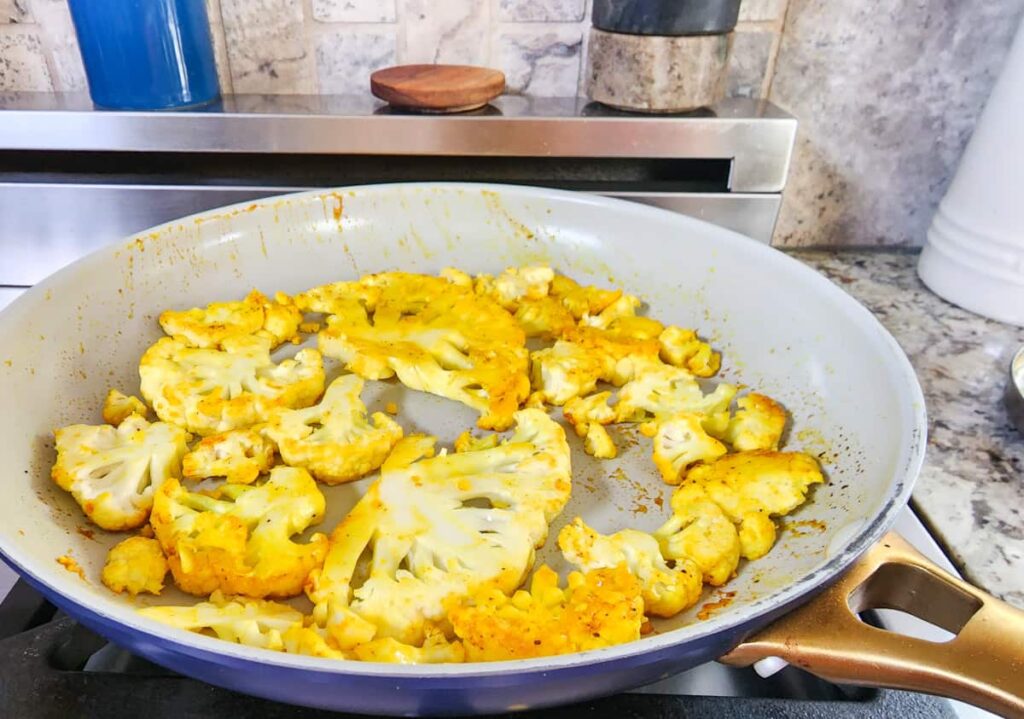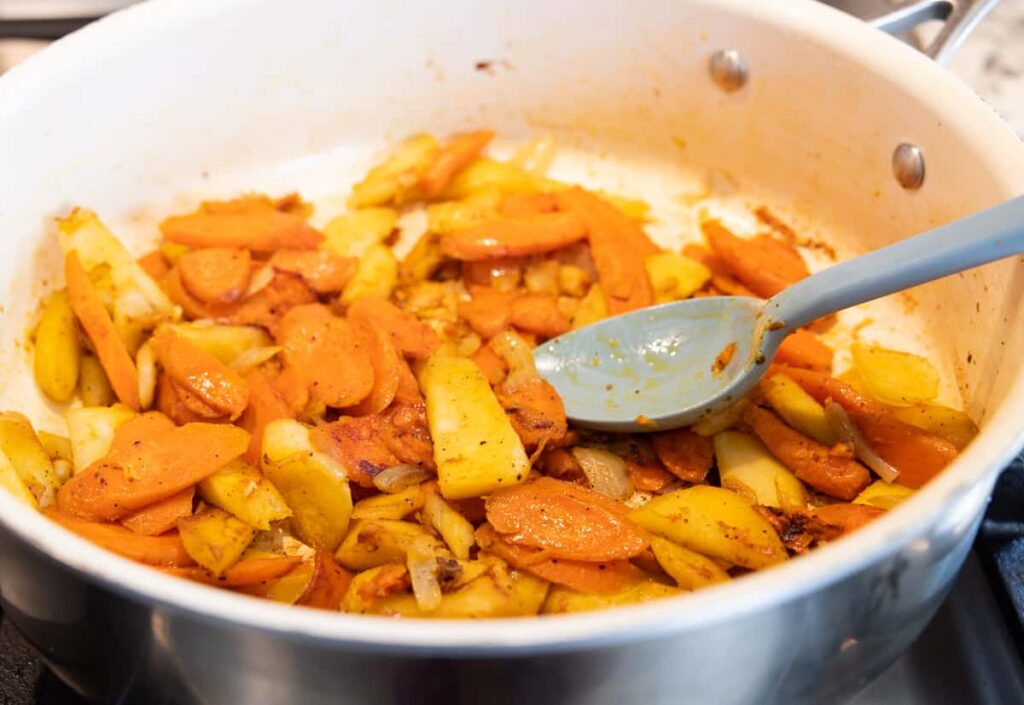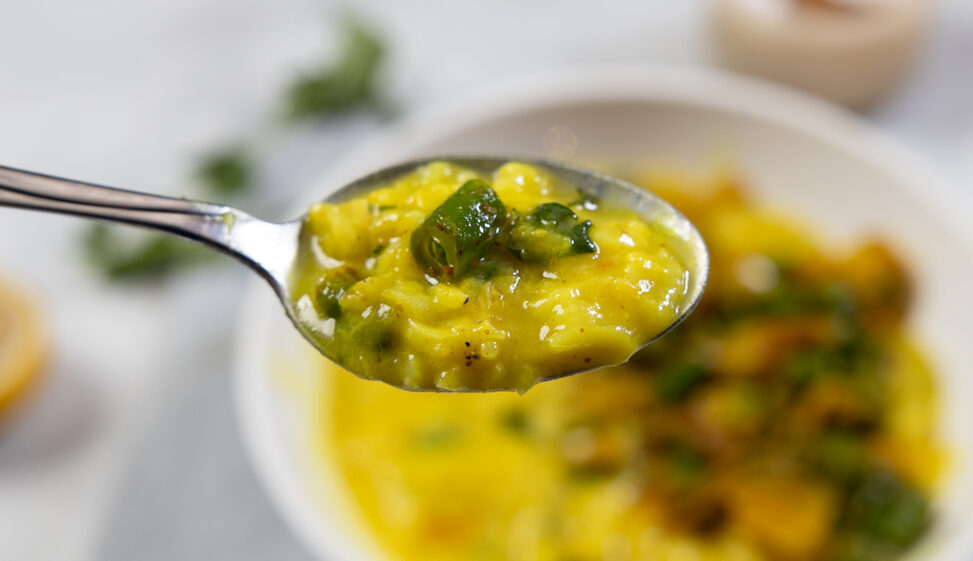This post may contain affiliate links. Please see our disclosure for more information.
The recipe below will make enough to last you for 3 or 4 meals.
Traditionally, for ease of digestion, kitchari is eaten more like a soup than a pilaf. This is why the recipe includes more water than you might normally think.
However, to change up the texture, you can also cook khichdi with less water. For a firmer textured khichdi, use 2 1/2 to 3 cups water, and cook for less time.


Sides for khichdi
Prepare any vegetable topping, South-Indian style. My favorite!
Indian-spiced Brussel sprouts

Vata Reducing Khichdi
Servings: 3 servings
Calories: 205kcal
A nourishing khichdi made with warming spices to support good digestion for Vata dosha
Print Recipe
Equipment
- medium saucepan with lid
Ingredients
for the khichdi
- 1/3 cup moong dal
- 1/3 cup basmati rice
- 4 cups water or vegetable broth
for the spice tempering
- 1 tablespoon ghee or olive oil
- 1/2 teaspoon black mustard seed (optional; supportive for enzymes, gas, bloating)
- 1/2 teaspoon turmeric
- 2 pinches asafetida (hing)
- 1 teaspoon ginger finely chopped or grated
to finish
- 1/2 teaspoon mineral salt or to taste
- 2 tablespoons cilantro freshly chopped
- 1/2 lemon freshly squeezed or to taste
Instructions
for the khichdi
- Wash the soaked split yellow moong dal until the water runs clear. Wash the rice once.
- Combine moong dal, rice, water, and a pinch of salt in a medium saucepan or INSTANT POT.
- Saucepan: Bring to a boil, then reduce heat to low, and simmer partially covered until very soft (about 30-40 minutes). Stir occasionally.Instant Pot: Close the lid and select “HIGH PRESSURE.” Set the timer for 10 minutes. Wait 15 minutes after cooking to open the lid. Release remaining pressure and open the lid.
for the spice tempering
- Add ghee or olive oil to small skillet on medium heat. Add mustard and cumin seeds first and cook, stirring frequently, until the mustard seeds start to pop and the cumin seeds turn a shade darker.
- Reduce heat to low or remove from heat momentarily if too hot. Add turmeric, asafetida and ginger. Sauté until the ginger is lightly browned, then transfer spices to the khichdi and stir.
to finish
- Add remaining salt to khichdi, and simmer for 2-3 minutes to marry the salt with the spices.
- Turn off the heat. Add fresh cilantro and lemon. Taste, and adjust for flavors. It should taste a little salty and lemony.
- Consider serving with a cooked vegetable topping or a condiment, such as cilantro chutney or ginger pickle.
Notes
Ratio of dal to rice
1:1 is good for Pitta, or anyone 3:1 is more cleansing, and appropriate for kapha dosha and spring season. 1:3 is more nourishing, and appropriate for vata dosha and fall season.Don’t like Indian spices? Other flavor options
Instead of using the spices in the recipe above, experiment with:- Italian herbs
- fresh dill with lemon or lime
- cinnamon and cloves
- salt with lemon and pepper
- garlic, salt, and pepper
How to add vegetables
Add chopped vegetables to the khichdi halfway through, or cook vegetables separately and enjoy as a topping.Breakfast khichdi
Try cinnamon, ginger, nutmeg, cardamom, allspice, clove and even a splash of homemade plant milk. You may also cook prunes or dates into the breakfast khichdi.Nutrition
Calories: 205kcal | Carbohydrates: 31g | Protein: 7g | Fat: 6g | Saturated Fat: 3g | Polyunsaturated Fat: 0.3g | Monounsaturated Fat: 2g | Cholesterol: 13mg | Sodium: 412mg | Potassium: 45mg | Fiber: 3g | Sugar: 1g | Vitamin A: 64IU | Vitamin C: 0.4mg | Calcium: 31mg | Iron: 1mg

This is so yum!